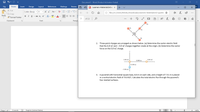Question
thumb_up100%
Three-point charges are arranged as shown below. (a) Determine the vector electric field that the 6.0 ?? and −3.0 ?? charges together create at the origin. (b) Determine the vector force on the 5.0 ?? charge.

Transcribed Image Text:Document1 - Word (Product Activation Failed)
File
Home
Insert
Design
Layout
References
Mailings
Review
A Learners-Materials3rd-c x +
re
X Cut
Calibri (Body) - 11
- A A
Aa -
O file:///C:/Users/MOJAL/Downloads/Learners-Materials3rd-quartei *
...
De Copy
Paste
BIU - abe x, x A - ay - A
Format Painter
of 23
+ ?
A
7
-
Clipboard
Font
Paragr.
2. Three-point charges are arranged as shown below. (a) Determine the vector electric field
that the 6.0 nC and –3.0 nC charges together create at the origin. (b) Determine the vector
force on the 5.0 nC charge.
5.00 nC
6.00 nC
0.500 m
0.100 m
-3.00 nC
3. A pyramid with horizontal square base, 8.8 m on each side, and a height of 7.31 m is placed
in a vertical electric field of 74.6 N/C. Calculate the total electric flux through the pyramid's
four slanted surfaces.
Page 1 of 1
O words
E English (United States)
+
148%
Expert Solution
This question has been solved!
Explore an expertly crafted, step-by-step solution for a thorough understanding of key concepts.
This is a popular solution
Trending nowThis is a popular solution!
Step by stepSolved in 3 steps

Knowledge Booster
Similar questions
- Two charged particles lie on the x-axis. The first particle has a +Q charge and is at x = -a. The amount of charge of the second particle is unknown and is at x = +5a. At the origin, the net electric field generated by these charges is -2ke Qlaii. What is the charge of the second particle?arrow_forwardThree point charges are arranged as shown in the figure below. 5.00 nC -3.00 nC 0.300 m 0.100 m Need Help? (a) Find the vector electric field that the q = 9.50 nC and -3.00 nC charges together create at the origin. N/CÎ + N/Cĵ 9 (b) Find the vector force on the 5.00 nC charge. UNô + μΝ j Read Itarrow_forwardTwo charges, qi =-1.069 µC and unknown charge q2 are separated by distance 6.92 cm, and placed with charge q1 to the left of charge q2, as shown in the picture below. Charge q2 exerts force F2 on 1 of magnitude 4.35 N that point in the negative x-direction. F2 on 1 91 92 ? What is the exact (not absolute) value of charge q2? Express your answer in microcoulombs, with a precision of three places after the decimal.arrow_forward
- The 50 ?? point charges are located on the x-axis. One is at ? = 1.00 ?, and the other is at ? =−1.00 ?. (a) Determine the electric field on the y-axis at ? = 0.500 ?. (c) Calculate the electric force on a −3.50 ?? charge placed on the y-axis at ? = 0.500 ?.arrow_forwardA positive point charge Q is located at x-a and a negative point charge -Q is at x = -a. A positive charge q can be placed anywhere on the y-axis. Find an expression for (FX, the x -component of the net force on q. Give your answer in terms of Q, q, a, y and constant K. Do your assessment by looking at (F)x when y = 0. net netarrow_forwardProblem 2. Three point charges are placed on the xy plane: (A) +50.0-nC charge at the origin, (B) -60.0-nC charge on the x axis at x = 1 0.0 cm, and (C) + 150-nC charge at the point (10.0 cm, 8.00 cm). Find the total electric force on the charge C and the electric field at the location of the charge C due to the presence of the +50.0- and -60.0-nC charges?arrow_forward
- Three charges are positioned at the corners of a parallelogram as shown above right. (a) If Q = 8.0 μC, what is the electric field at the unoccupied corner? (b) What is the force on a 5.0–μC charge placed at this corner?arrow_forwardA charge +q is located at the origin. A charge - 2q is at 3.15 m on the x axis. (a) For what finite value of x is the electric field zero? 7 Xm To the right of both charges, which charge is always closest? Does it have the smaller or larger charge? At what locations are there two field contributions that can cancel to produce zero net field? (b) For what finite value(s) of x is the electric potential zero? x m Because the charge of -2q is closer than the charge of +q for this value of x, the 2q dominates and the total field cannot be zero. m smaller value larger valuearrow_forwardA 6 µC charge q1 located at the origin cm creates an electric field that fills all of space. A -8 µC charge q2 is brought to the point cm. The 6 µC charge is returned but now the -8 µC charge is moved to cm. What is the new net force extered on q2? Answer as a vector in Newtons.arrow_forward
arrow_back_ios
arrow_forward_ios